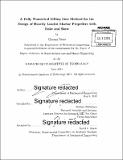A fully numerical lifting line method for the design of heavily loaded marine propellers with rake and skew
Author(s)
Diniz, Giovani
DownloadFull printable version (10.05Mb)
Other Contributors
Massachusetts Institute of Technology. Department of Mechanical Engineering.
Advisor
Stefano Brizzolara.
Terms of use
Metadata
Show full item recordAbstract
This thesis aims to give a contribution to the design of heavily loaded marine propellers by numerical methods. In this work, a wake-adapted, fully numerical, lifting line model is used to obtain the optimum circulation distribution along the propeller's blade via variational method, presented by Coney [9]. In this context, two approaches to the representation of the wake field are compared: the first approach utilizes Betz's condition for moderately loaded propellers, in which the wake is aligned with the hydrodynamic pitch angle. The second approach, in which the wake is aligned with the local velocities, utilizes Kutta's Law to create a zero-lift wake surface. A thorough comparison of the influence of the effect of tip vortex roll-up is done. A lifting surface method with fully aligned wake is developed and used to correct the optimum distribution of pitch and camber obtained by the new lifting line method. The resulting geometries, operating under heavily-loaded conditions, are submitted to a preliminary analysis in a boundary element-based potential flow code to verify the consistency of the results. This analysis confirms the better results obtained with the fully numerical lifting line model and the variations between the approaches in terms of circulation and pitch angle observed in the lifting line results are verified. Finally, the performance of propeller geometries generated with the approaches studied in this work are compared by high fidelity RANSE analysis. The CFD simulations confirm the higher accuracy of the method in which the wake geometry is aligned with the local velocities in terms of fulfillment of thrust requirement.
Description
Thesis: S.M. in Naval Architecture and Marine Engineering, Massachusetts Institute of Technology. Department of Mechanical Engineering, 2015. Cataloged from PDF version of thesis. Includes bibliographical references (pages 85-86).
Date issued
2015Department
Massachusetts Institute of Technology. Department of Mechanical EngineeringPublisher
Massachusetts Institute of Technology
Keywords
Mechanical Engineering.